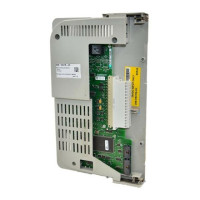Motor Control Modes 51
Motor Control Modes [Motor Cntl Sel] selects the output mode of the drive. The choices are:
• Custom Volts/Hertz
Used in multi-motor or synchronous motor applications.
• Fan/Pump Volts/Hertz
Used for centrifugal fan/pump (variable torque) applications to achieve
maximum energy savings.
• Sensorless Vector
Used for most constant torque applications. Provides excellent starting,
acceleration and running torque.
• Sensorless Vector w/Economizer
Used for additional energy savings in constant torque applications that have
constant speed reduced load periods.
• Flux Vector
Used when high performance speed regulation or torque regulation is required.
• Adjustable Voltage
Typically used for non-motor applications such as resistive loads, welding
equipment and power supplies, but also linear motors.
The following table shows the performance differences between V/Hz, Sensorless
Vector and Flux Vector.
Volts/Hertz
Volts/Hertz operation creates a fixed relationship between output voltage and
output frequency. The relationship can be defined in two ways.
1. Fan/Pump
When this option is chosen, the relationship is 1/x
2
. Therefore;
for full frequency, full voltage is supplied and for 1/2 rated frequency,
1/4 voltage is applied, etc. This pattern closely matches the torque requirement
of a variable torque load (centrifugal fan or pump – load increases as speed
increases) and offers the best energy savings for these applications.
70EC
700VC
700H
✔✔
Torque Mode
Fan/Pump and
Custom V/Hz
with Slip Comp
SVC with
Slip Comp
SVC with
Feedback
Flux Vector
without
Feedback
Flux Vector
with Feedback
Speed Regulation
(% of base speed)
0.5% 0.5% 0.1% 0.1% 0.001%
Operating Speed Range 40:1 80:1 80:1 120:1 1000:1
Speed Bandwidth 10 rad/sec 20 rad/sec 20 rad/sec 50 rad/sec ≥125 rad/sec
Torque Regulation N/A N/A N/A ≤10% ≤5%
700VC
ONLY
Maximum Voltage
Maximum
Frequency
Base Voltage
(Nameplate)
Base Frequency
(Nameplate)
Run Boost

